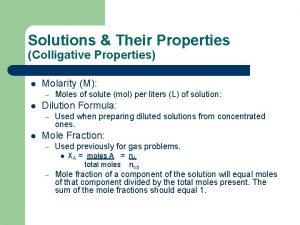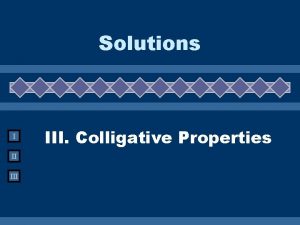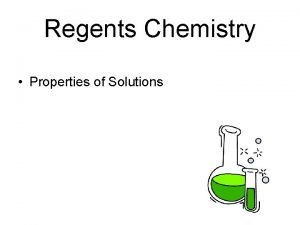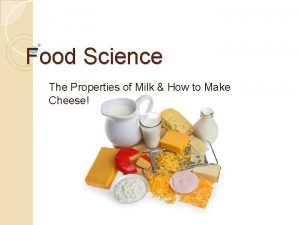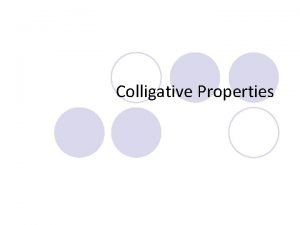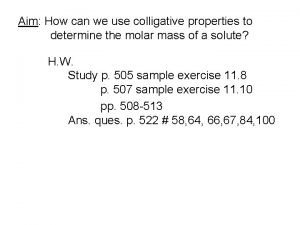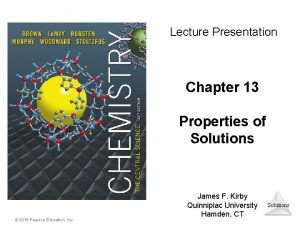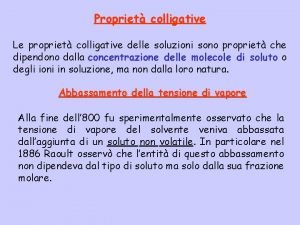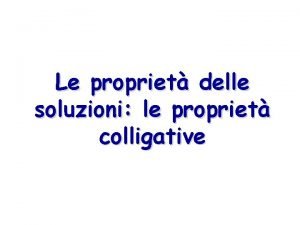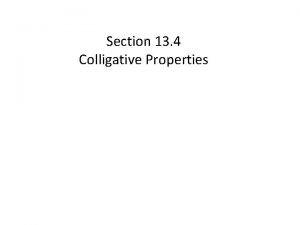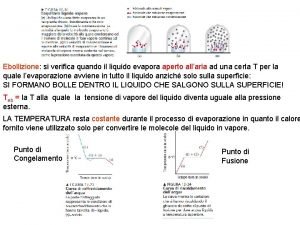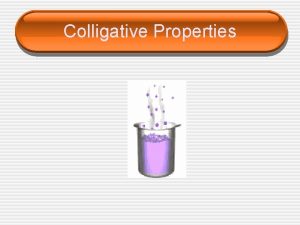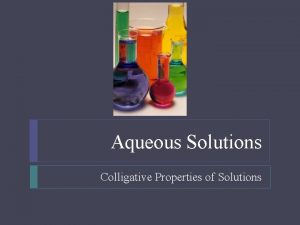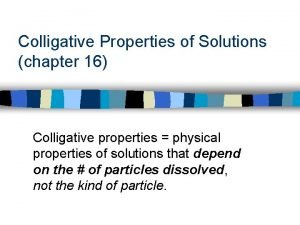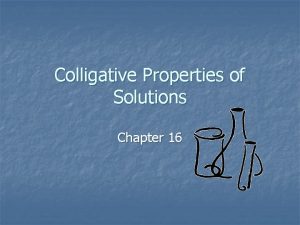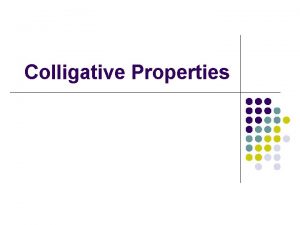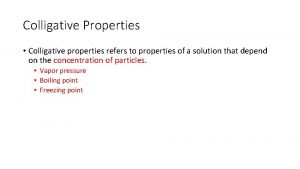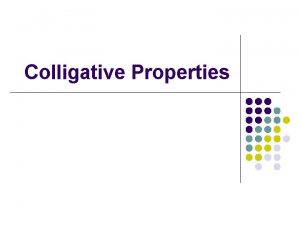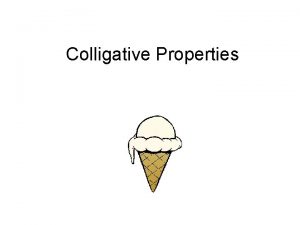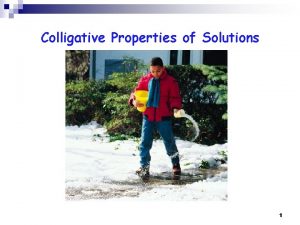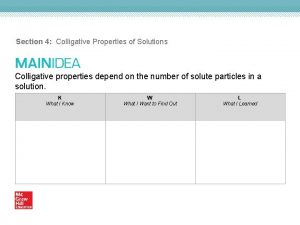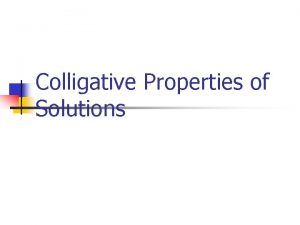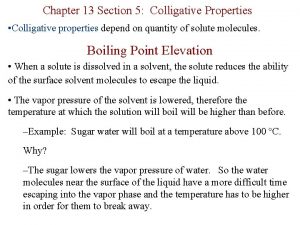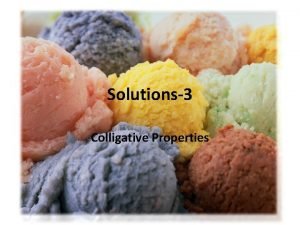16 3 Colligative Properties of Solutions Chapter 16










































- Slides: 42

16. 3 Colligative Properties of Solutions > Chapter 16 Solutions 16. 1 Properties of Solutions 16. 2 Concentrations of Solutions 16. 3 Colligative Properties of Solutions 16. 4 Calculations Involving Colligative Properties 1 Copyright © Pearson Education, Inc. , or its affiliates. All Rights Reserved.

16. 3 Colligative Properties of Solutions > CHEMISTRY & YOU Why do you need salt to make ice cream? Ice-cream makers know that if you add rock salt to ice, the mixture freezes at a few degrees below 0°C. 2 Copyright © Pearson Education, Inc. , or its affiliates. All Rights Reserved.

16. 3 Colligative Properties of Solutions > Describing Colligative Properties What are three colligative properties of solutions? 3 Copyright © Pearson Education, Inc. , or its affiliates. All Rights Reserved.

16. 3 Colligative Properties of Solutions > Describing Colligative Properties Tea is not the same as pure water. • Some of these differences in properties have little to do with the specific identity of the solute. • Instead, they depend upon the mere presence of solute particles in the solution. 4 Copyright © Pearson Education, Inc. , or its affiliates. All Rights Reserved.

16. 3 Colligative Properties of Solutions > Describing Colligative Properties A colligative property is a property of solutions that depends only upon the number of solute particles, not upon their identity. 5 Copyright © Pearson Education, Inc. , or its affiliates. All Rights Reserved.

16. 3 Colligative Properties of Solutions > Describing Colligative Properties Three important colligative properties of solutions are • vapor-pressure lowering • freezing-point depression • boiling-point elevation 6 Copyright © Pearson Education, Inc. , or its affiliates. All Rights Reserved.

16. 3 Colligative Properties of Solutions > Describing Colligative Properties Vapor-Pressure Lowering Vapor pressure is the pressure exerted by a vapor that is in dynamic equilibrium with its liquid in a closed system. 7 Copyright © Pearson Education, Inc. , or its affiliates. All Rights Reserved.

16. 3 Colligative Properties of Solutions > Describing Colligative Properties Vapor-Pressure Lowering Vapor pressure is the pressure exerted by a vapor that is in dynamic equilibrium with its liquid in a closed system. • A solution that contains a solute that is nonvolatile (not easily vaporized) always has a lower vapor pressure than the pure solvent. 8 Copyright © Pearson Education, Inc. , or its affiliates. All Rights Reserved.

16. 3 Colligative Properties of Solutions > Describing Colligative Properties Vapor-Pressure Lowering Higher vapor pressure Pure solvent Solvent particle Equilibrium is established between the liquid and vapor in a pure solvent. 9 Lower vapor pressure Solution containing nonvolatile solute Solute particle In a solution, solute particles reduce the number of solvent particles able to escape the liquid. Equilibrium is established at a lower vapor pressure. Copyright © Pearson Education, Inc. , or its affiliates. All Rights Reserved.

16. 3 Colligative Properties of Solutions > Describing Colligative Properties Vapor-Pressure Lowering Ionic solutes that dissociate have greater effects on vapor pressure than does a nondissociating solute. 10 Copyright © Pearson Education, Inc. , or its affiliates. All Rights Reserved.

16. 3 Colligative Properties of Solutions > Describing Colligative Properties Vapor-Pressure Lowering Ionic solutes that dissociate have greater effects on vapor pressure than does a nondissociating solute. • Three moles of sodium chloride dissolved in water produce 6 mol of particles because each formula unit of Na. Cl dissociates into two ions. 11 Copyright © Pearson Education, Inc. , or its affiliates. All Rights Reserved.

16. 3 Colligative Properties of Solutions > Describing Colligative Properties Vapor-Pressure Lowering Ionic solutes that dissociate have greater effects on vapor pressure than does a nondissociating solute. • Three moles of calcium chloride dissolved in water produce 9 mol of particles because each formula unit of Ca. Cl 2 dissociates into three ions. 12 Copyright © Pearson Education, Inc. , or its affiliates. All Rights Reserved.

16. 3 Colligative Properties of Solutions > Describing Colligative Properties Vapor-Pressure Lowering Ionic solutes that dissociate have greater effects on vapor pressure than does a nondissociating solute. • Three moles of glucose dissolved in water produce 3 mol of particles because glucose does not dissociate. 13 Copyright © Pearson Education, Inc. , or its affiliates. All Rights Reserved.

16. 3 Colligative Properties of Solutions > Describing Colligative Properties Vapor-Pressure Lowering The decrease in a solution’s vapor pressure is proportional to the number of particles the solute makes in solution. 14 Copyright © Pearson Education, Inc. , or its affiliates. All Rights Reserved.

16. 3 Colligative Properties of Solutions > Describing Colligative Properties Vapor-Pressure Lowering Which solution has the lowest vapor pressure? 15 Copyright © Pearson Education, Inc. , or its affiliates. All Rights Reserved.

16. 3 Colligative Properties of Solutions > Describing Colligative Properties Vapor-Pressure Lowering Which solution has the lowest vapor pressure? • The vapor-pressure lowering caused by 0. 1 mol of Na. Cl in 1000 g of water is twice that caused by 0. 1 mol of glucose in the same quantity of water. 16 Copyright © Pearson Education, Inc. , or its affiliates. All Rights Reserved.

16. 3 Colligative Properties of Solutions > Describing Colligative Properties Vapor-Pressure Lowering Which solution has the lowest vapor pressure? • In the same way, 0. 1 mol of Ca. Cl 2 in 1000 g of water produces three times the vapor-pressure lowering as 0. 1 mol of glucose in the same quantity of water. 17 Copyright © Pearson Education, Inc. , or its affiliates. All Rights Reserved.

16. 3 Colligative Properties of Solutions > Describing Colligative Properties Freezing-Point Depression When a substance freezes, the particles of the solid take on an orderly pattern. 18 Copyright © Pearson Education, Inc. , or its affiliates. All Rights Reserved.

16. 3 Colligative Properties of Solutions > Describing Colligative Properties Freezing-Point Depression When a substance freezes, the particles of the solid take on an orderly pattern. • The presence of a solute in water disrupts the formation of this pattern. 19 Copyright © Pearson Education, Inc. , or its affiliates. All Rights Reserved.

16. 3 Colligative Properties of Solutions > Describing Colligative Properties Freezing-Point Depression When a substance freezes, the particles of the solid take on an orderly pattern. • The presence of a solute in water disrupts the formation of this pattern. • As a result, more kinetic energy must be withdrawn from a solution than from the pure solvent to cause the solution to solidify. 20 Copyright © Pearson Education, Inc. , or its affiliates. All Rights Reserved.

16. 3 Colligative Properties of Solutions > Describing Colligative Properties Freezing-Point Depression The freezing point of a solution is lower than the freezing point of the pure solvent. 21 Copyright © Pearson Education, Inc. , or its affiliates. All Rights Reserved.

16. 3 Colligative Properties of Solutions > Describing Colligative Properties Freezing-Point Depression The freezing point of a solution is lower than the freezing point of the pure solvent. • The difference in temperature between the freezing point of a solution and the freezing point of the pure solvent is called the freezing -point depression. 22 Copyright © Pearson Education, Inc. , or its affiliates. All Rights Reserved.

16. 3 Colligative Properties of Solutions > Describing Colligative Properties Freezing-Point Depression Freezing-point depression is another colligative property. • The magnitude of the freezing-point depression is proportional to the number of solute particles dissolved in the solvent and does not depend upon their identity. 23 Copyright © Pearson Education, Inc. , or its affiliates. All Rights Reserved.

16. 3 Colligative Properties of Solutions > Describing Colligative Properties Freezing-Point Depression The freezing-point depression of aqueous solutions plays an important role in helping keep travelers safe in cold, icy weather. 24 Copyright © Pearson Education, Inc. , or its affiliates. All Rights Reserved.

16. 3 Colligative Properties of Solutions > Describing Colligative Properties Freezing-Point Depression The freezing-point depression of aqueous solutions plays an important role in helping keep travelers safe in cold, icy weather. • The truck spreads a layer of salt on the icy road to make the ice melt. • The melted ice forms a solution with a lower freezing point than that of pure water. 25 Copyright © Pearson Education, Inc. , or its affiliates. All Rights Reserved.

16. 3 Colligative Properties of Solutions > Describing Colligative Properties Boiling-Point Elevation The boiling point of a substance is the temperature at which the vapor pressure of the liquid phase equals atmospheric pressure. 26 Copyright © Pearson Education, Inc. , or its affiliates. All Rights Reserved.

16. 3 Colligative Properties of Solutions > Describing Colligative Properties Boiling-Point Elevation The boiling point of a substance is the temperature at which the vapor pressure of the liquid phase equals atmospheric pressure. • Adding a nonvolatile solute to a liquid solvent decreases the vapor pressure of the solvent. 27 Copyright © Pearson Education, Inc. , or its affiliates. All Rights Reserved.

16. 3 Colligative Properties of Solutions > Describing Colligative Properties Boiling-Point Elevation The boiling point of a substance is the temperature at which the vapor pressure of the liquid phase equals the atmospheric pressure. • Adding a nonvolatile solute to a liquid solvent decreases the vapor pressure of the solvent. • Because of the decrease in vapor pressure, additional kinetic energy must be added to raise the vapor pressure of the liquid phase of the solution to atmospheric pressure and initiate boiling. 28 Copyright © Pearson Education, Inc. , or its affiliates. All Rights Reserved.

16. 3 Colligative Properties of Solutions > Describing Colligative Properties Boiling-Point Elevation The boiling point of a solution is higher than the boiling point of the pure solvent. 29 Copyright © Pearson Education, Inc. , or its affiliates. All Rights Reserved.

16. 3 Colligative Properties of Solutions > Describing Colligative Properties Boiling-Point Elevation The boiling point of a solution is higher than the boiling point of the pure solvent. • The difference in temperature between the boiling point of a solution and the boiling point of the pure solvent is the boiling-point elevation. 30 Copyright © Pearson Education, Inc. , or its affiliates. All Rights Reserved.

16. 3 Colligative Properties of Solutions > Describing Colligative Properties Boiling-Point Elevation The fluid circulating through a car’s cooling system is a solution of water and ethylene glycol, or antifreeze. • The antifreeze doesn’t just lower the freezing point of the water in the cooling system. • It also elevates the boiling point, which helps protect the engine from overheating in the summer. 31 Copyright © Pearson Education, Inc. , or its affiliates. All Rights Reserved.

16. 3 Colligative Properties of Solutions > Describing Colligative Properties Boiling-Point Elevation Boiling-point elevation is a colligative property; it depends on the concentration of particles, not on their identity. 32 Copyright © Pearson Education, Inc. , or its affiliates. All Rights Reserved.

16. 3 Colligative Properties of Solutions > Describing Colligative Properties Boiling-Point Elevation Boiling-point elevation is a colligative property; it depends on the concentration of particles, not on their identity. • The magnitude of the boiling-point elevation is proportional to the number of solute particles dissolved in the solvent. – The boiling point of water increases by 0. 512°C for every mole of particles that the solute forms when dissolved in 1000 g of water. 33 Copyright © Pearson Education, Inc. , or its affiliates. All Rights Reserved.

16. 3 Colligative Properties of Solutions > CHEMISTRY & YOU Solutes other than Na. Cl could be used to produce the same freezingpoint depression in an ice-cream machine. What factors do you think make Na. Cl a good choice? 34 Copyright © Pearson Education, Inc. , or its affiliates. All Rights Reserved.

16. 3 Colligative Properties of Solutions > CHEMISTRY & YOU Solutes other than Na. Cl could be used to produce the same freezingpoint depression in an ice-cream machine. What factors do you think make Na. Cl a good choice? Na. Cl, or rock salt, is readily available, inexpensive, and nontoxic. It is an ionic compound. It produces twice the freezing-point depression of a molecular solid such as sucrose, or table sugar. 35 Copyright © Pearson Education, Inc. , or its affiliates. All Rights Reserved.

16. 3 Colligative Properties of Solutions > You have 500 m. L of 1 M solutions of Na. Cl, Na 2 SO 4, Na 3 PO 4, and Al 2(SO 4)3. Which solution will have the highest boiling point? A. Na. Cl(aq) B. Na 2 SO 4(aq) C. Na 3 PO 4(aq) D. Al 2(SO 4)3(aq) 36 Copyright © Pearson Education, Inc. , or its affiliates. All Rights Reserved.

16. 3 Colligative Properties of Solutions > You have 500 m. L of 1 M solutions of Na. Cl, Na 2 SO 4, Na 3 PO 4, and Al 2(SO 4)3. Which solution will have the highest boiling point? A. Na. Cl(aq) B. Na 2 SO 4(aq) C. Na 3 PO 4(aq) D. Al 2(SO 4)3(aq) 37 Copyright © Pearson Education, Inc. , or its affiliates. All Rights Reserved.

16. 3 Colligative Properties of Solutions > Key Concepts Colligative properties of solutions include vapor-pressure lowering, freezing-point depression, and boiling-point elevation. 38 Copyright © Pearson Education, Inc. , or its affiliates. All Rights Reserved.

16. 3 Colligative Properties of Solutions > Glossary Terms • colligative property: a property of a solution that depends only upon the number of solute particles, and not upon their identities; boilingpoint elevation, freezing-point depression, and vapor-pressure lowering are colligative properties 39 Copyright © Pearson Education, Inc. , or its affiliates. All Rights Reserved.

16. 3 Colligative Properties of Solutions > Glossary Terms • freezing-point depression: the difference in temperature between the freezing point of a solution and the freezing point of the pure solvent • boiling-point elevation: the difference in temperature between the boiling point of a solution and the boiling point of the pure solvent 40 Copyright © Pearson Education, Inc. , or its affiliates. All Rights Reserved.

16. 3 Colligative Properties of Solutions > BIG IDEA The Mole and Quantifying Matter Solubility, miscibility, concentration, and colligative properties are used to describe and characterize solutions. 41 Copyright © Pearson Education, Inc. , or its affiliates. All Rights Reserved.

16. 3 Colligative Properties of Solutions > END OF 16. 3 42 Copyright © Pearson Education, Inc. , or its affiliates. All Rights Reserved.
 Ions in aqueous solutions and colligative properties
Ions in aqueous solutions and colligative properties Why are colligative properties important
Why are colligative properties important Propriété colligative des solutions
Propriété colligative des solutions 4 colligative properties
4 colligative properties Molarity and molality are colligative properties.
Molarity and molality are colligative properties. Colligative property definition
Colligative property definition Definition of colligative property
Definition of colligative property Solutions chemistry regents questions
Solutions chemistry regents questions Colligative properties of milk
Colligative properties of milk Non colligative properties examples
Non colligative properties examples Colligative properties worksheet
Colligative properties worksheet Properties of l
Properties of l Boiling point elevation
Boiling point elevation 4 colligative properties
4 colligative properties Colligative properties depend on
Colligative properties depend on Colligative properties example problems
Colligative properties example problems Costherm
Costherm Fluid property calculator
Fluid property calculator Calculating molar mass using colligative properties
Calculating molar mass using colligative properties Colligative properties notes
Colligative properties notes Raoult's law
Raoult's law Application of colligative properties in pharmacy
Application of colligative properties in pharmacy Colligative properties of seawater
Colligative properties of seawater Chapter 13 properties of solutions
Chapter 13 properties of solutions Proprietà colligative
Proprietà colligative Proprietà colligative delle soluzioni
Proprietà colligative delle soluzioni Coefficiente di van't hoff
Coefficiente di van't hoff Vapor pressure lowering
Vapor pressure lowering Proprietà colligative
Proprietà colligative Abbassamento crioscopico
Abbassamento crioscopico Estrazione con solvente zanichelli
Estrazione con solvente zanichelli Reocentral
Reocentral Physical properties of solutions
Physical properties of solutions Solutes and solvents grade 7 science
Solutes and solvents grade 7 science General properties of aqueous solutions
General properties of aqueous solutions Visitor management solutions for properties
Visitor management solutions for properties Physical properties of solutions
Physical properties of solutions Difference between intensive and extensive properties
Difference between intensive and extensive properties Is smell a physical property
Is smell a physical property Population proportion
Population proportion Chapter 14 financial statement analysis solutions
Chapter 14 financial statement analysis solutions Signals and systems oppenheim solutions chapter 5
Signals and systems oppenheim solutions chapter 5 Intermediate accounting revenue recognition
Intermediate accounting revenue recognition




